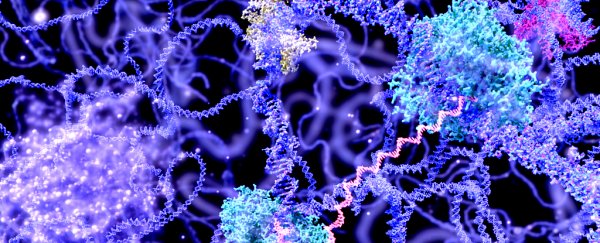You've probably heard of CRISPR - the gene editing tool that essentially lets scientists cut and paste DNA, removing things like HIV and muscular dystrophy from our cells - and now scientists have discovered a way to edit RNA with just as much precision.
RNA is DNA's close biological cousin, responsible for translating messages from the nucleus to the rest of the cell, and being able to change it could open up all-new disease-fighting possibilities.
Just like CRISPR/Cas9 editing, the new procedure selectively cuts up RNA, which gives us microscopic control over genetic information, and the researchers behind it say it could open up the method could be used to block viruses and halt disease in its tracks.
"RNA is the blueprint through which genes regulate cellular processes," biologist Oliver Rackham at the University of Western Australia, who wasn't involved in the study, told Colin Barras from New Scientist. "The exciting thing about this study is that it now opens up the RNA world to the ease of experimental design afforded by CRISPR."
While DNA carries the genetic code for our bodies, RNA carries out those instructions and puts that code to work. Basically, DNA has the recipes but RNA reads that recipe and directs all the cooking.
And while scientists used to think the RNA was just a 'middleman', they've realised over the past few decades that it does so much more than that - it can control which proteins are produced in the cell.
In fact, the original CRISPR/Cas9 method uses a combination of DNA and RNA information to target viruses in the body, and identify genetic code that needs replacing. But right now, it focusses solely on DNA.
Now an international team of scientists, led by Feng Zhang from the Broad Institute of MIT and Harvard, has discovered another version of CRISPR called C2c2, and it can be used to slice up RNA molecules exclusively.

Just like CRISPR/Cas9, the C2c2 system was discovered inside bacteria, where it works like a pair of molecular scissors to 'cut out' any invading pathogen's RNA in order to disable an attack.
But the difference is that C2c2 only targets RNA, not DNA itself, which means scientists can use it to make changes and control what happens within a cell, without changing the genetic code itself.
Zhang's team tested the system by inserting C2c2 into E. coli bacteria, and showed they were able to use it to silence a gene simply by targeting RNA. This is because they attacked the RNA carrying the instructions from the gene, so the gene was effectively turned off, without the DNA being touched.
The researchers say C2c2 should also be able to bind to RNA without cutting it up, which would allow scientists to track the movement of RNA in a cell and monitor the effect that changing genetic information has on a single cell, or throughout the whole body.
Whereas DNA changes are permanent, RNA changes could be tweaked as treatment progresses, which gives a lot more opportunity for fighting disease.
"C2c2 opens the door to an entirely new frontier of powerful CRISPR tools," said Zhang. "There are an immense number of possibilities for C2c2, and we are excited to develop it into a platform for life science research and medicine."
While the technique did produce some collateral damage in this study - some RNA that looked similar to the target molecules was unintentionally attacked - it's still early days, and Rackham told New Scientist that the feature could actually be useful in some treatments.
"In a cancer treatment, for example, wiping out 'bystander' RNA as well as target RNA might offer a more effective way to fight a tumour," reports Barras.
This isn't the first time scientists have been able to target RNA instead of DNA through gene-editing techniques, but the difference is C2c2 uses a more natural and more versatile approach, and potentially has a range of different uses. We can't wait to see what scientists do with it.
The results of the study have been published in Science.
